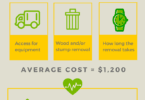Homeowners should do a regular assessment of their property to make sure it is in good condition. One part of this assessment is to take a good look at your trees. Do you have any dangerous diseased or dead branches? Are your trees overgrown and leaning against your house? It may just be time to prune them back for the growing season. Whatever the case may be, it is important to use the proper techniques when trimming a tree.
Contents
When to Trim a Tree
Dead branches, diseased branches or dangerously low hanging branches can be trimmed at any time of the year. As a general rule, spring is a good time to shape your trees for the most aesthetic appeal. In the summer, do some careful pruning to help promote healthy growth of your trees. In winter, the dormant season for most deciduous trees, a good trimming is often needed. Flowering trees must first blossom before they can bloom and display their beauty. A good rule of thumb is to wait a few weeks after blooming and then trim, being careful not to cut off the blooms.
Special Situations
Several different types of trees should only be pruned at certain times of year. Maple trees tend to bleed sap from pruning cuts and while this is not particularly harmful to the tree it is messy and unattractive. To avoid this situation, prune when fully dormant which is the middle of winter. In the months of April and May, Dogwoods are susceptible to the dogwood borer, an insect that bores into the tree and causes serious damage to the tree’s vascular system. Finally Oak trees should not be trimmed from April to October as they can contract Oak Wilt disease.
What Part of the Tree Do You Trim?
It is important to make your cuts in the right part of the tree. If you cut the branch too far away from the trunk and leave a large stub it can cause trouble. Once the stub dies, it becomes an easy entry point for insects and other pathogens that can cause damage and even kill a tree. Proper tree trimming requires making cuts close to the collar of the branch being pruned. The collar is the swollen area at the base of the branch and has the important function of protecting the tree against damaging infestation. When cutting, be sure to leave the swollen area intact, but don’t leave a protruding stub.
Removing Small Branches
Small branches can safely be removed with loppers or a small hand saw. Before you start hacking away, survey the tree from all sides and get a good picture in your mind of how you want the tree to look. Start with the lowest hanging branches and work your way around the tree. Step back and see how the job is progressing. Trim until you have achieved the look you desire.
Removing Large Branches
Sometimes you will have a huge branch that is dead or just hanging way too low to the ground. Removing such a branch can be dangerous if you don’t know what you are doing. You may be able to get by with a pruning saw, but a chainsaw may be a better choice. In order to safely remove the branch, start by making a cut about two feet from the trunk on the underside of the branch. Cut about one third of the way through the branch. Then, from above, Cut straight through and the branch should fall without damaging the trunk. You can now safely go back and trim the stub back to an inch or so from the collar.







